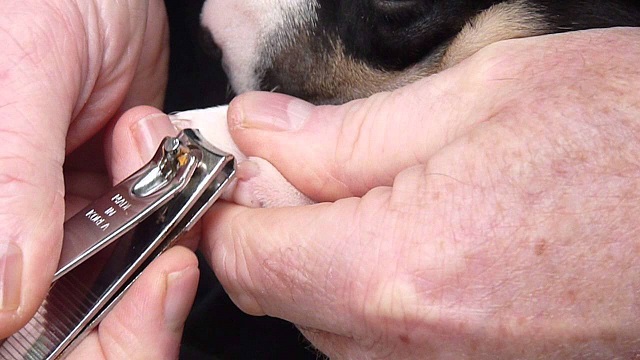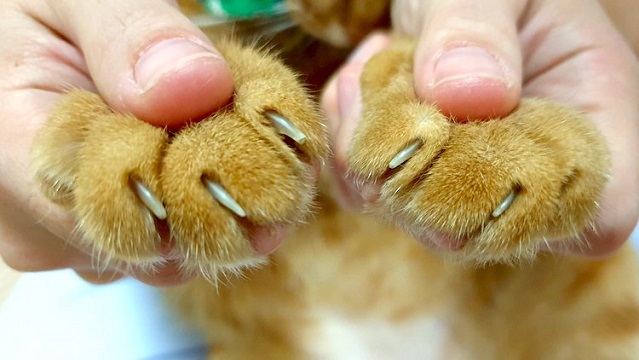Cutting cat nails with Human Nail Clippers might be easy, but we suggest you follow the veterinarian’s advice. Human nail clippers may split the nails further making the nails rough and uncomfortable. These nail clippers sometimes pinch, which will make it difficult for you to handle your cat.
Moreover, human nail clippers don’t work well if your cat has very small or thick nails. In contrast, the Feline Clippers are designed to clip a cat’s nail securely. Therefore, it is always good to use the best cat nail clippers to cut cat nails. If for some reason you have to use human clippers to cut cat nails then be very careful.
Cats more often do not like to get their nails trimmed. However, you might prefer to cut their nails at regular intervals because they hurt you or your children. Trimming cat nails[2] is the best alternative than declawing the cat. Often, a cat gets used to it after a few regular sessions of nail cutting.

How to Cut Cat Nails With Human Clippers
Guillotine type, Scissors type, and Human fingernail clippers are few of the choices available to cut cat nails. The scissors-type can be used if a nail is curling inside and growing too long. For any reason, if you are using Human Nail Clippers then you should follow a few pieces of advice.
Step 1: Hold Your Cat
Some cats might quietly cooperate with you while others might not let you cut their nails. The best way to avoid extreme movements while using human nail clippers is to wrap your cat in a towel. Take one of her paws out to trim the nails and wrap rest of the legs. You will need one more person to hold your cat’s head still while you trim her nails.
Step 2: Give Treats to Your Cat
Give your cat tasty treats every time you cut her nails. She will find it rewarding to get the nails cut. As a result, she will calmly sit and will positively get her nails groomed.
Step 3: Press the Paw Gently:
Cat’s nails are mostly hidden inside the furs. To have a better view of the claws, press her paw gently which will push the nails out and furs upwards. Hence it will give you a proper view of the nails.
Step 4: Cut the Tips of the Nails
Turn a human nail clipper sideways to cut the cat’s nail. Our main goal is to trim only the pointed end of the claw. If you will cut closer to the pink part of the nail called quick, then you will get an intensely negative response from your cat.
If mistakenly you cut the quick then it will start bleeding. So make sure you never cut the quick.
Step 5: Cut other Nails in a Similar Way
Repeat the process for all other claws while holding your cat. Keep your cat wrapped and keep her head still. Take out just one paw at a time to cut the nails and repeat the same process for others.
If wrongly you have cut a quick, then your cat might hide from you or may get aggressive. Wait until she calms down. The bleeding shall stop on its own in some time. Talk to a vet for any medications if required.

A Few Facts About Cat Claws
Cat claws are not like human nails. When clipping the nails[1] with a human nail clipper we should be cautious about the following facts.
Cats catch prey with their claws: The innermost claws on the front paws are the dewclaws. The cat uses them to catch prey.
Cats are digitigrades: Humans are plantigrade walkers as they walk on the sole of their foot. In contrast, cats walk on their toes, and therefore they are digitigrade walkers. Cats will face trouble in balancing if we declaw them.
Cat’s front claws are sharp: When the cat walks, her front claws don’t touch the ground. Hence the front claws do not suffer any wear and tear and remain sharp. It also helps the cat to walk quietly while sneaking up on her prey.
Rear claws wear out: Most cats do not require trimming the rear claws as they wear down through routine walking.
Cat’s claws are curvy at the ends: The curvy claws help them in holding their prey and also in climbing. But these also get stuck in things such as carpets and consequently injure their toes.
The Claws Grow All Her Life: Cats’ nails grow regularly, just as in humans. Cats may bite her nails or scratch through it and wear them down. As a result, they become dull and shed at times. Older cats do fewer activities, hence their nails do not shed much. So older cats need cutting the nails more often.
There are other popular cat grooming tools available in the market to ensure the safety of your feline.
Ask a Veterinarian
If you are not sure you can handle your cat while trimming her claws, you better go to the professionals. As described earlier, human nail clippers are not the best option to trim your cat’s claws.
Your cat might get fearful while you trim her nails. However, the vet very well knows how to calm the cat and groom her nails with a proper feline clipper.
References
- Clipping your cat’s claws. VetMed. (n.d.). Retrieved September 5, 2022, from http://cvmcms.vetmed.wsu.edu/outreach/Pet-Health-Topics/categories/procedures/cats/clipping-your-cat’s-claws
- Contributors, W. M. D. E. (2021, June 28). Cat nail clipping: How and when to trim your cat’s claws. WebMD. Retrieved September 5, 2022, from https://pets.webmd.com/cats/guide/cat-nail-clipping-care


Hi I just started clipping my cats nails. I recently adopted her. I give her a treat each time I clip a nail. Will this work? Hope she gets used to it. She gets nervous when she knows I’m about to clip a nail. I tried to clip a nail again today and she jumped off bed. I’ll have to give her a break and try tomorrow before her nap.
Julie
Your love, affection, and treats are all that your kitty needs to make her comfortable with you while you are clipping her nails. If your cat still feels nervous upon seeing the nail clipper then you can first create a positive association with the nail trimmers. This can be done by placing the trimmers next to your cat’s food bowl during meals or positioning a saucer or bowl of canned food around the clippers.